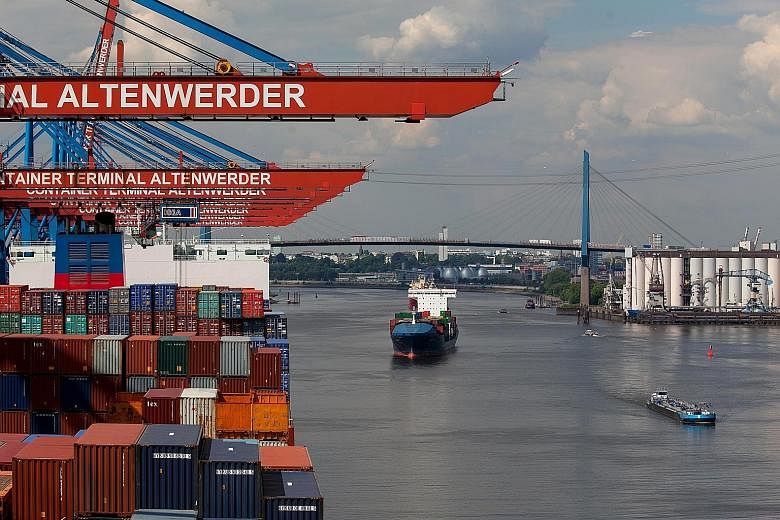The Port of Charleston spent most of the early 2000s enjoying double-digit growth as a rising wave of globalisation - fuelled by a rising China and a consumer boom in the United States - brought robust volumes of cargo into the seaport.
Those days are long gone. South Carolina Ports Authority chief Jim Newsome says he would be happy with 3 per cent growth this year - a goal he concedes could be too ambitious. In January, container traffic at the port fell 5.1 per cent from levels posted in the previous year, and the strong greenback is causing problems for US exporters.
"Most of the exporters I talk to are just not doing the same business they were a year ago," he says.
The story is repeated and amplified far beyond Charleston. Last year saw the largest collapse in the value of goods traded around the world since 2009 - when the impact of the global financial crisis was at its worst. Moreover, major ports such as Hamburg and Singapore have reported slowing growth and even declining volumes.
Barring a spectacular turnaround in the global economy, the subpar performance is likely to be repeated this year, making it the fifth straight year of lacklustre growth in global trade - a pattern not seen since the doldrums of the 1970s.
"It has been a very long time since trade... has grown this weakly," says Mr Robert Koopman, chief economist at the World Trade Organisation.
Largely to blame are the economic slowdown in China and the knock-on effect that its declining appetite for commodities has had on other emerging markets. Europe's anaemic recovery has added to headwinds hitting global commerce.
Some experts say there are even greater factors at work.
Increasingly, economists are arguing that the slowdown is not merely cyclical, but also a sign that the forces that have driven globalisation for decades are starting to shift.
The first big transition is China's attempt to rebalance from a manufacturing and export-led economy towards one focused on domestic consumption.
And some economists note that the plateau in worldwide trade in goods and capital has coincided with a surge in data flows - an indicator, they say, that the digital economy of the 21st century is starting to overturn the old order.
Economists at the McKinsey Global Institute point to increased automation and new manufacturing technologies, including 3D printing, to support the argument that the change is likely to accelerate.
Combined, these factors bode ill for the future of global trade in goods.
"The image that many of us still have in our minds of globalisation is that picture of the huge cargo container ships taking boatloads of manufactured goods from factories in far-flung places and delivering them to markets around the world," says Dr Susan Lund, one of the authors of a McKinsey report.
"What we see in front of us is a globalisation that has morphed in a very different and more digital direction."
WELCOME TO THE DIGITAL WORLD
Even as flows of finance, goods and services have slowed - falling from a peak of 53 per cent of global output in 2007 to 39 per cent in 2014 - growth in cross-border data has surged. The flow of digital information around the world more than doubled between 2013 and last year, to an estimated 290 terabytes per second, McKinsey says.
The figure will grow by a third again this year - by year-end, companies and individuals around the world will have sent 20 times more data across borders than they did in 2008.
The change, McKinsey argues, goes beyond the advent of smartphones, apps, streaming services and data-hungry digital products such as Facebook and video game Candy Crush Saga.
It is already in evidence at major companies including General Electric, which is using 3D printers to make fuel nozzles for jet engines and expects its aviation unit to churn out 100,000 parts using this technology by 2020.
Such innovations bring closer the day when companies will make far greater use of the capacity to receive equipment not by container ship, but by a digital set of orders destined for a 3D printer.
THE RISE OF DATA
McKinsey argues there are already signs of the economic value of that new form of globalisation. By its calculations, cross-border flows of capital, goods, services and data added an extra US$7.8 trillion (S$10.9 trillion) to the global economy in 2014.
The added value of data flows alone accounted for US$2.8 trillion of that total - slightly exceeding the US$2.7 trillion attributed to the global trade in goods.
The arrival of this digital economy has coincided with a shortening of global supply chains - a phenomenon that the International Monetary Fund and the World Bank warned about in 2014.
In a report, they said that as much as half of the post-crisis slowdown in global trade could be attributed to "structural" rather than cyclical factors.
Among the factors cited was Beijing's move to swallow up entire supply chains, which means Chinese manufacturers are increasingly producing many intermediate parts they once imported for assembly.
McKinsey argues that those moves, replicated in the US and elsewhere, have had a global impact, as carmakers and other companies have begun to bring production closer to home or to concentrate it in larger markets.
Those patterns are starting to show in the data, with growth in global consumption of many finished products such as cars and pharmaceuticals outpacing trade growth in those goods in recent years, says McKinsey, while trade in many intermediate goods such as fabric and electrical parts has slowed.
AFTERMATH OF DOWNTURN
Some still argue that the greatest drag on trade remains an old- fashioned economic downturn.
In recent years, "we have seen whammy after whammy hit the global economy", says former World Bank economist Bernard Hoekman, who now heads the trade and investment programme at the European University Institute. That, he argues, has had an inevitable impact on trade.
HSBC senior trade economist Douglas Lippoldt says that since the global crisis, trade has lost two of its greatest drivers.
"In normal times, it takes at least two cylinders to get trade firing. You need consumers... and you need investment to be firing. So far, we haven't seen that," he says.
Stalled corporate investment in segments such as factory machinery means less trade, he points out.
Consumer confidence, meanwhile, remains fragile almost eight years after the height of the crisis.
As trade has slowed in recent years, many of the world's largest economies have engaged in a new round of liberalisation.
The US, Japan and 10 other countries concluded negotiations for the Trans-Pacific Partnership last year, with similar efforts under way between Washington and Brussels and in South-east Asia. But any economic benefit could take years to materialise and be the subject of intense scrutiny, especially in the US.
Mr Koopman and others say the slowdown in global commerce could still be offset by another transition in China, which he says is already under way.
With its New Silk Road foray to redevelop ancient trade routes in South-east Asia, Central Asia and the Middle East, Beijing is in many ways emulating what Japan did following the 1980s Plaza Accord, when a dollar depreciation against the yen triggered a move by Japanese firms to send lower-value manufacturing overseas while keeping higher-value production at home.
There should be plenty of room as well for economies in Africa and Latin America and even India to take up China's mantle and feed the next round of growth in global trade, Mr Koopman contends. Whether as sources of rising demand for overseas goods or as new export powers, all could contribute to another burst of globalisation.
A surprising finding in the McKinsey study is just how concentrated world trade remains, with roughly a dozen major economies accounting for the vast bulk of global flows in capital, goods and even data. That could leave room for more countries to emerge as 21st-century trading powers once the global economy finds its footing again.
The inescapable truth is that global trade has slowed and that few economists expect a rebound any time soon.
Back at the Port of Charleston, Mr Newsome says his hopes for its future lie with the investment he sees around him in South Carolina and with exporters, rather than with any pickup in the global economy or trade more broadly.
"That is just the new reality that we are living with right now," he says.
FINANCIAL TIMES


